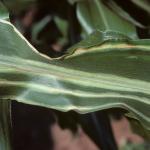Corn, Stewart's Wilt
Pantoea (Erwinia) stewartii
Stewart's Wilt of sweet corn, caused by Pantoea (Erwinia) stewartii, continues to be a problem in most sweet corn producing areas of the Northeast. The disease is caused by a bacterium that can spread systemically throughout the plant. Symptoms appear at any stage of plant growth. Severity of Stewart’s Wilt depends on three factors: 1) the winter temperatures prior to planting 2) the amount of disease the previous season and 3) cultivar susceptibility. If cold winter temperatures occur, fewer flea beetles survive to transmit the disease. The amount of disease in the previous season determines the percentage of emerging beetles carrying the bacterium.
Identification:
Two phases of Stewart's bacterial wilt occur. The first phase affects seedlings, which become systemically infected and rapidly wilt. Systemic infections occur at or before the 5-leaf stage. The seedling may develop linear pale green to yellow streaks, wilts, and dies. The second (leaf blight) phase of Stewart’s Wilt occurs when older plants are infected. Long, white to yellow streaks develop along leaves and entire leaves may dry up and die, suggesting drought or nutritional stress. Highly susceptible varieties may exhibit vascular discoloration in stems and at leaf nodes.
Life Cycle:
P. stewartii overwinters in the alimentary tract of adult corn fleas beetles, not in the soil or in plant debris. The beetles hibernate as adults and in the spring feed on corn and other grasses allowing the bacteria to enter the plant. Seedling wilt occurs at or before the 5-leaf stage as the bacterium enters the plant, spreads to the developing stalk, and kills the growing point.
Crop Injury:
Loss of leaf tissue results in small, poorly filled, and unmarketable ears. Greatest loss occurs when the plants are infected as seedlings; damage is reduced as plants mature. High levels of nitrogen and phosphorous, high temperatures, and high soil moisture levels enhance disease incidence and severity.
Monitoring & Thresholds:
Scout frequently for flea beetles as rapid growth of leaf tissue makes untreated surfaces available.
Cultural Controls & Prevention:
- Grow varieties that are resistant to the disease. Information on cultivar susceptibility is available online at http://sweetcorn.illinois.edu/. Hybrids with greater levels of resistance can tolerate more infection with less yield loss. Resistance restricts the movement of the bacteria in the plant.
- Many dent corn hybrids and inbreds have resistance to the seedling blight phase.
- Insecticides applied as seed treatments or in-furrow have been effective.
- Avoid excess nitrogen and phosphorous levels as well as excess soil moisture.
Chemical Controls & Pesticides:
Use insecticides to control flea beetles, particularly on susceptible varieties in the seedling stage. This is not as effective as resistant varieties, but reduces losses where susceptible hybrids must be planted.(Gaucho) seed treatments provide systemic control of corn flea beetles and reduce the severity of Stewart’s Wilt.
For Current information on disease recommendations ins specific crops including information on chemical control & pesticide management, please visit the New England Vegetable Management Guide website.
Crops that are affected by this disease:
The Center for Agriculture, Food and the Environment and UMass Extension are equal opportunity providers and employers, United States Department of Agriculture cooperating. Contact your local Extension office for information on disability accommodations. Contact the State Center Director’s Office if you have concerns related to discrimination, 413-545-4800 or see ag.umass.edu/civil-rights-information.

